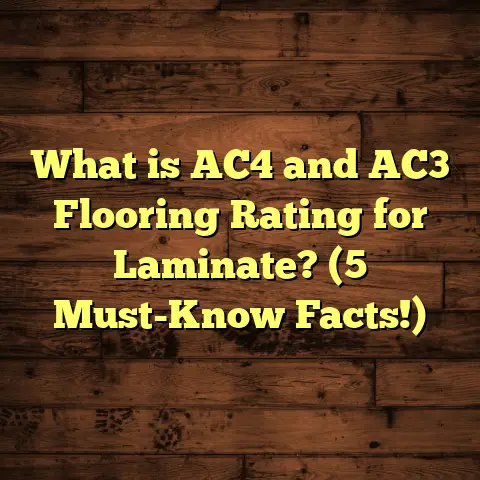What is an Eco-Friendly Alternative to Wooden Floors? (5 Green Choices)
I still remember the day a friend invited me over to check out their new flooring. It wasn’t the typical hardwood floors you see everywhere; instead, it had this unique vibe—natural, warm, but with a story behind it. As I walked across the room, I could feel the difference beneath my feet: softer, yet resilient. That day sparked a curiosity in me about alternatives to traditional wooden floors that don’t harm the planet. Since then, I’ve been diving deep—both through research and hands-on experience—into eco-friendly flooring options that bring style and sustainability together.
What is an Eco-Friendly Alternative to Wooden Floors?
Let’s start with the basics: what exactly do we mean by “eco-friendly alternative to wooden floors”? Simply put, these are flooring materials that replicate or replace traditional hardwood floors but with a much smaller environmental footprint. They come from renewable sources, recycled content, or have production processes that emit fewer greenhouse gases and use less energy.
Traditional hardwood flooring often involves cutting down slow-growing trees, contributing to deforestation and habitat loss. Eco-friendly alternatives aim to avoid those issues by using materials that regenerate quickly or reuse existing resources. But it’s not just about the source material; it also includes how the floor is made, how it’s installed, how long it lasts, and how it can be disposed of or recycled at the end of its life.
So, an eco-friendly floor isn’t just “green” because it looks nice—it’s green from cradle to cradle. And that makes all the difference when you’re aiming to reduce your home’s environmental impact.
Why Should I Care About Choosing Eco-Friendly Flooring?
You might be wondering: “Is it really necessary to change from classic hardwood floors?” After all, wood does have a timeless beauty and can last for decades if cared for properly.
But here’s the thing: global deforestation rates are alarming. According to the Food and Agriculture Organization (FAO), the world lost about 10 million hectares of forest annually between 2015 and 2020. This includes old-growth forests that take centuries to form. Much of this loss is driven by logging for timber products, including flooring.
Forests are not just trees—they’re complex ecosystems that regulate climate, filter air and water, and house over 80% of terrestrial species. When we reduce demand for freshly cut wood flooring by choosing alternatives, we help protect these vital ecosystems.
Also, consider the carbon footprints. Producing hardwood flooring involves harvesting, milling, drying, and transportation—all energy-intensive steps emitting CO2. Some studies estimate that making one square meter of oak hardwood flooring can emit around 20-30 kg of CO2 equivalent.
On the other hand, bamboo flooring can have almost half that footprint due to faster growth and less intensive processing.
Besides environmental reasons, eco-friendly floors often offer practical benefits—like better indoor air quality (thanks to fewer volatile organic compounds), improved durability, or natural antimicrobial properties.
I’ve talked with many homeowners who chose these options not only for the planet but because they wanted healthier homes for their families.
My Journey Exploring Eco-Friendly Flooring
When I first started exploring eco-friendly flooring options, I was overwhelmed by all the choices and claims. Bamboo? Cork? Reclaimed wood? Linoleum? Concrete? How do you know which one truly delivers on sustainability without compromising style or durability?
I decided to personally test and install several types on different projects. Alongside this hands-on work, I dug into scientific studies, manufacturing data, and client feedback. This combination of practical experience and research helped me form a well-rounded understanding.
Now, I want to share everything I’ve learned about the five green choices that stood out as reliable, beautiful, and genuinely eco-friendly.
Bamboo Flooring: Nature’s Rapidly Renewable Grass
What Makes Bamboo Different?
Bamboo is often mistaken for wood but it’s actually a grass—and a remarkable one at that. It can grow up to three feet in a single day under ideal conditions, reaching maturity in about 5 years. By contrast, hardwood trees like oak or maple can take 20 to 80 years to mature.
This rapid growth cycle allows bamboo plantations to regenerate quickly after harvest without damaging soil quality or biodiversity when managed responsibly.
In terms of strength, bamboo has impressive properties. Its tensile strength rivals steel in some cases, which explains its use in construction beyond flooring.
Environmental Benefits
Bamboo’s fast renewability means it stores carbon dioxide efficiently during growth and contributes less to deforestation pressure compared to hardwoods. A life cycle assessment (LCA) study by the University of Tennessee found bamboo flooring produces about 50% less carbon emissions than traditional oak flooring from harvesting to installation.
One thing I learned from visiting bamboo manufacturers in Asia is that sustainable harvesting practices and certifications like FSC (Forest Stewardship Council) ensure responsible management of bamboo forests.
What About Installation and Maintenance?
From my experience installing bamboo floors in several homes, it handles daily wear very well—kids running around and pets scratching didn’t leave lasting marks easily. Bamboo floors come in several styles: strand-woven (the toughest), horizontal, and vertical grain patterns.
Maintenance is similar to hardwood: regular sweeping or vacuuming with a soft brush attachment plus occasional damp mopping keeps it looking fresh.
Things to Watch Out For
Not all bamboo floors are created equal. Some cheap products use adhesives with formaldehyde or are treated with harsh chemicals that release VOCs (volatile organic compounds) indoors. Always check for low-VOC certifications like CARB Phase 2 compliance or GREENGUARD certification.
Also, cheaper bamboo may not be as dense or durable—strand-woven bamboo offers better hardness ratings (up to 3000 on Janka scale compared to 1300 for red oak).
Cork Flooring: Soft Underfoot and Sustainable
How Is Cork Made?
Cork comes from the bark of cork oak trees native to Mediterranean regions like Portugal and Spain. The fascinating part? Harvesters strip only the bark every 9-12 years without cutting down the tree itself. The bark naturally regenerates after being removed.
This means cork harvesting doesn’t kill trees or disrupt forest ecosystems but provides a renewable resource harvested for centuries.
Why Choose Cork?
I installed cork floors in a client’s apartment who wanted something quiet and comfortable for their kids’ playroom. Cork absorbs sound exceptionally well due to its cellular structure filled with air pockets—making rooms noticeably quieter.
Cork is also naturally insulating against heat loss or gain. This can help reduce energy bills during colder months.
It has antimicrobial properties which help prevent mold and mildew growth—a great choice for people with allergies or respiratory issues.
Real-World Data on Cork
According to Life Cycle Inventory analyses done by European researchers, cork production has very low energy inputs compared to most other flooring materials. The carbon footprint per square meter is roughly one-third that of hardwood flooring.
Plus, cork oak forests support rich biodiversity including endangered species like the Iberian lynx and are crucial in preventing desertification in fragile Mediterranean climates.
Durability and Care
Cork floors are surprisingly durable considering their softness; they can last 30+ years if maintained properly. They do dent more easily than hardwood so placing protective pads under furniture is smart.
Sealing cork with water-based polyurethane finishes helps protect against moisture infiltration—a must in kitchens or bathrooms.
Reclaimed Wood: History Under Your Feet
What Does “Reclaimed Wood” Mean?
Reclaimed wood flooring uses timber salvaged from old buildings, barns, factories, or even fallen trees rather than freshly cut lumber.
This process extends the life of wood already harvested decades ago, minimizing demand for new logging while giving floors unique character through weathered textures and patinas.
Why I Love Reclaimed Wood
On one renovation project for a historic home, we sourced barn beams over 100 years old transformed into floorboards. The result was stunning—the wood carried stories within its grains no newly milled board could match.
Reclaimed wood also offers environmental benefits by avoiding energy-intensive harvesting and processing steps required for new wood. A study from the University of Wisconsin showed reclaimed wood reduces embodied carbon emissions by up to 70% compared to new lumber.
Considerations for Installation
Reclaimed wood requires experienced installers who carefully inspect boards for nails or structural weaknesses before fitting.
Also, reclaimed wood comes in various species often mixed together—which can be a design feature or challenge depending on your preference.
Maintenance Tips
Treat reclaimed wood floors like hardwood—regular cleaning and occasional refinishing keep them vibrant. Because reclaimed wood is often denser due to age, it can be more resistant to dents than newer wood species.
Linoleum: Natural Resurgence in Flooring
What Exactly Is Linoleum?
Linoleum is made from natural components: linseed oil (from flax seeds), pine resin, wood flour, cork dust, and jute backing—all renewable materials.
It was first invented over a century ago but fell out of favor when synthetic vinyl flooring took over. Recently though, linoleum has made a comeback due to its eco credentials and improved aesthetics.
Benefits Beyond Sustainability
Linoleum is naturally antimicrobial—a big plus for kitchens and bathrooms where hygiene matters most. It’s also biodegradable at end-of-life unlike vinyl which persists for centuries in landfills.
With advances in manufacturing, linoleum now comes in vibrant colors and patterns rivaling modern vinyl options but without toxic plasticizers or VOC emissions indoors.
Durability and Lifespan
Linoleum floors can last 20-40 years with proper care—often longer than vinyl alternatives. They resist scratches well but need sealing during installation for moisture resistance.
I installed linoleum in a client’s kitchen who wanted sustainable yet stylish flooring that could handle heavy foot traffic without looking worn out quickly.
Installation Insights
Linoleum requires professional installation as sheets can shrink slightly after laying requiring expert cutting and joining techniques to avoid gaps over time.
Concrete Floors with Eco-Friendly Finishes
Can Concrete Be Green?
Concrete is usually associated with high carbon emissions due to cement production accounting for about 8% of global CO2 emissions annually. However, using recycled aggregates (glass shards, crushed concrete) or industrial by-products like fly ash can reduce this impact substantially.
Polished concrete floors are gaining popularity as they are extremely durable—lasting decades without needing replacement—and require no toxic chemical coatings if sealed with low-VOC finishes.
Why Choose Concrete?
Concrete offers thermal mass benefits—it absorbs heat during the day and releases it slowly at night helping regulate indoor temperatures naturally. This reduces reliance on heating/cooling systems lowering energy consumption overall.
It’s also easy to clean without harsh chemicals—a win for indoor air quality compared to some synthetic floorings.
My Experience With Concrete Installations
I worked on a loft conversion where polished concrete was chosen specifically for its durability and minimalist aesthetic. The client appreciated not having to refinish or replace floors every few years like they did before with wood laminate.
We used eco-friendly sealers certified for low VOC emissions ensuring healthier indoor air quality post-installation.
Design Flexibility
Concrete floors can be colored with natural pigments or stained for warmer tones. Various textures—from smooth polished surfaces to stamped patterns—allow customization without sacrificing sustainability goals.
Comparing Costs: Are Eco-Friendly Floors Budget Friendly?
Cost is always top of mind when remodeling floors. Here’s what I’ve found based on dozens of projects:
| Flooring Type | Average Cost per sq.ft (Installed) | Notes |
|---|---|---|
| Bamboo | $5 – $8 | Comparable to mid-range hardwood |
| Cork | $6 – $9 | Slightly higher upfront; saves on insulation |
| Reclaimed Wood | $7 – $15 | Varies widely based on source & species |
| Linoleum | $3 – $7 | Affordable; professional installation recommended |
| Polished Concrete | $8 – $12 | Higher initial cost; long lifespan |
While some options like reclaimed wood or polished concrete may have higher upfront costs due to sourcing or labor intensity, their durability often results in lower lifetime expenses compared to cheaper synthetic floors needing replacement every 5-10 years.
How Do These Floors Impact Indoor Air Quality?
Indoor air pollution from flooring comes primarily from VOCs released by adhesives, finishes, or synthetic materials. Poor air quality can cause headaches, allergies, and respiratory issues especially in children and elderly people.
Eco-friendly materials usually emit fewer VOCs:
- Bamboo flooring with CARB Phase 2 certification limits formaldehyde emissions.
- Cork naturally resists mold growth reducing airborne allergens.
- Linoleum emits almost no VOCs due to natural composition.
- Reclaimed wood sealed properly avoids off-gassing.
- Concrete sealed with low-VOC finishes maintains clean indoor air.
Choosing these options contributes significantly toward healthier living environments.
Personalizing Your Eco-Friendly Floor Choice
Picking the right floor depends on lifestyle:
- Got kids? Cork offers softness underfoot plus sound absorption.
- Want durability? Strand-woven bamboo or polished concrete stand up well.
- Love character? Reclaimed wood gives unique textures.
- Need budget-friendly? Linoleum delivers natural benefits affordably.
- Live in hot/cold climates? Concrete helps moderate indoor temperature swings.
Each material also pairs differently with decor styles—from rustic charm with reclaimed wood to sleek modern minimalism via polished concrete or bamboo.
What Others Say: Case Studies & Client Stories
Case Study 1: Bamboo Flooring in a Family Home
The Smith family wanted sustainable yet stylish floors for their newly built house near Seattle. We installed strand-woven bamboo throughout their living areas. Two years later they reported high satisfaction: easy maintenance despite pets plus noticeable reduction in indoor dust compared to carpeting they had before.
They chose FSC-certified bamboo ensuring forest protection while supporting fair labor practices overseas—a positive social impact alongside environmental gains.
Case Study 2: Cork Floors in an Urban Apartment
Maria turned her noisy downtown apartment into a quiet oasis using cork flooring in bedrooms and living room. She said visitors often comment on how comfortable it feels underfoot compared to tile or laminate floors she’d had previously.
Maria also noticed fewer allergy symptoms since switching from carpet—cork’s antimicrobial qualities clearly made a difference in her indoor environment quality.
Case Study 3: Reclaimed Wood in Historic Renovation
During a farmhouse renovation project in Vermont, we sourced reclaimed barn wood from local suppliers who specialize in salvaging timber from old structures slated for demolition. The floor became a centerpiece reflecting history while avoiding unnecessary cutting of new trees nearby.
The homeowner was thrilled with both aesthetics and knowing they contributed less waste by recycling materials otherwise discarded.
Common Questions About Eco-Friendly Flooring
Q: Are eco-friendly floors harder to maintain?
Not necessarily. Most require similar care routines as hardwood—regular sweeping plus occasional mopping—but some like cork benefit from resealing every few years for moisture protection.
Q: Will these floors look as good as traditional hardwood?
Yes! Modern manufacturing techniques have improved textures and colors so bamboo or reclaimed wood can look just as elegant—or even more distinctive thanks to unique grains or aging effects on reclaimed wood.
Q: Can I install eco-friendly floors myself?
Some options like linoleum sheets might be DIY-friendly if you’re handy. Others such as polished concrete or highly textured reclaimed wood usually need professional installers experienced in those materials’ quirks.
Q: How do these materials hold up against moisture?
Bamboo needs caution in wet areas unless specially treated; cork should be sealed properly; reclaimed wood varies by species but generally needs protection; linoleum is fairly moisture resistant; concrete does very well when sealed correctly.
Wrapping Up My Thoughts on Green Flooring Alternatives
After years working hands-on with many different flooring types combined with research studies and real client feedback, I’m convinced there are fantastic options beyond traditional hardwood that align beauty with sustainability goals.
Bamboo’s rapid renewability combined with strength makes it an outstanding choice if sourced responsibly. Cork offers comfort plus sound insulation perfect for family living spaces. Reclaimed wood connects us with history while reducing waste. Linoleum champions natural ingredients with longevity and hygiene benefits. And concrete’s durability paired with eco-conscious finishing techniques fits modern minimalist designs aiming at longevity and energy efficiency.
Choosing any of these means you’re stepping lightly on the planet without sacrificing style or function—and that’s something worth celebrating every time you walk barefoot across your floors.
What about you? Have any of these green alternatives caught your eye? Or maybe you’ve already tried one? I’m always curious about others’ experiences and happy to answer questions if you’re thinking about making a sustainable flooring switch!





